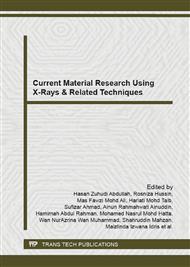p.20
p.25
p.30
p.35
p.40
p.45
p.50
p.55
p.59
Study of XRD and FESEM Characterization of Cellulose from Hardwood Waste of Resak (Vatica spp.)
Abstract:
Cellulose is one of the most abundant biomass material in nature extracted from natural fibers. Its hierarchical structure allows different kinds of microfibril cellulosic fillers to be obtained known as cellulose microfibril or microfibrillated cellulose (MFC). MFC is generally prepared by either acid hydrolysis, or chemical treatments, or by a high pressure refiner. In this study, attempts have been made to extract MFC from Resak’s hardwood waste (Vatica spp.) at atmospheric pressure using single-stage peroxyacetic acid delignification and Totally Chlorine-Free bleaching methods. The morphology structure of samples were characterized using Field emission scanning electron microscope (FESEM) and X-ray diffraction (XRD).
Info:
Periodical:
Pages:
40-44
Citation:
Online since:
February 2015
Price:
Сopyright:
© 2015 Trans Tech Publications Ltd. All Rights Reserved
Share:
Citation:


